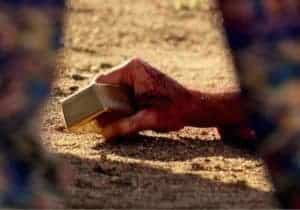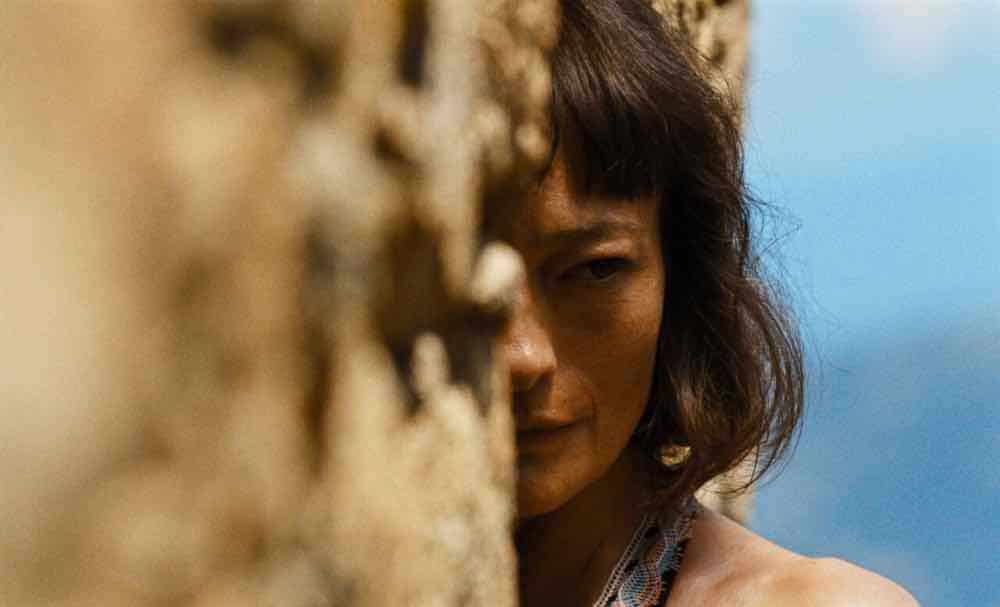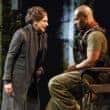Directors Hélène Cattet and Bruno Forzani discuss Let the Corpses Tan, adapting a novel for the first time, creating visceral rather than ornamental images, and the unique approach they demand from their actors. Read the rest of our TIFF coverage here.

With only three feature films under their belt but a strong and peculiar style, writing and directing duo Hélène Cattet and Bruno Forzani have already made a name for themselves. Echoing very specific, bygone sub-genres, their films are more than mere homages. Indeed, Cattet and Forzani are more interested in the visceral potential of images than they are in their beauty or vintage value. Their first feature, Amer (2009), offered a mind-bending, female-centered spin on giallo cinema, while The Strange Colour of your Body’s Tears (2013) reappropriated images and obsessions from the films of Dario Argento to create an entirely new sensation of frenzy and fear.
With Let the Corpses Tan, the couple has created its most hypnotic and haptic work to date. With its roots in the polizieschi (the Italian crime film of the late 1960s-1970s) but also in the spaghetti western, the film blends both highly stylised genres into an experience of the senses as psychologically engaging as it is physically involving. Brought together by a bank robbery gone sour, an ensemble of mismatched characters find themselves willing to do anything for the gold. Under the punishing Mediterranean sun, greed, illusions, and desire blend into an explosive mix that left this viewer exhilarated.
Back in Toronto, Seventh Row interviewed Cattet and Forzani on the occasion of the film’s North American premiere. The creative duo talked about adapting a novel for the first time, creating visceral rather than ornamental images, their collaborative process, and the unique approach they demand from their actors.
Seventh Row (7R): How did you get the idea for Let the Corpses Tan?
Hélène Cattet: More than a decade ago, I was working in a bookstore. There was a re-release of all of Jean-Patrick Manchette’s novels, and I came across his first one, Laissez bronzer les cadavres!, co-written with Jean-Pierre Bastid. I read it, and it was like discovering a universe that I was very familiar with. It was crazy! So many images came to my mind — from westerns, from polizieschi [Italian crime films]. I told Bruno to read it. I never imagined I would ever adapt a novel to the screen, but I thought this was a story we could really do something with.
Bruno Forzani (BF): After The Strange Colour of Your Body’s Tears, which was a really dark film, we needed to make something more radiant and bright, to let us breathe a little. This project was perfect for that.
[clickToTweet tweet=”‘Every element is taken for a word in a sentence. If a shot is wrong, the entire sequence collapses.'” quote=”‘Every element is taken for a word in a sentence. If a shot is wrong, the entire sequence collapses.'”]
7R: Your films are very much focused on visuals, but it would be wrong to say that they have no narrative. In Let the Corpses Tan, there are moments where plot is communicated in a rather conventional fashion, through the dialogue. How do you find this balance between communicating purely through an image, and doing so through dialogue?
Bruno Forzani: We make these decisions at the writing stage.
Hélène Cattet: We write directly with all the cinematographic elements from the start. When we write a scene, we already have in mind the editing, the music, the sound effects, etc. In this case, there was also the dialogue from the novel. We cut out a lot of it. We usually have even less of it.
Bruno Forzani: In the dialogue sequences, we try to tell through the directing something other than what the dialogue is communicating— something underlying the dialogue. There were some actions in the book that were not initially very visual, for example, the attraction between two characters. We tried each time to render them in a visual way, or at least in a visceral way, with the different cinematographic tools that were at our disposal.
[clickToTweet tweet=”‘Making the film a visceral experience and not an ornament demands a lot of preparation.’ – Forzani” quote=”‘Making the film a visceral experience and not an ornament demands a lot of preparation.’ – Forzani”]
7R: In all your films, there is often an excess to your images, and to all the aspects of the film in general. It’s almost like you’re drawing attention to this effect you are creating. For example, when there is a gunshot, it is completely foregrounded, and you often repeat the sound a dozen times. How do you manage to have this effect of excess without creating empty images? It’s a problem that a lot of supposedly ‘visual’ filmmakers have: they create strong visuals that have no true meaning or effect upon the viewer.
Hélène Cattet: From the start, we always try to really create a language, to make every shot tell something specific. We can’t arrive on set and say, “Oh, we’ll just improvise.” Everything has been prepared in advance, so that every shot reacts to the previous one, to the next one, and maybe even to the one that comes after that. Maybe the shot will even come back, but it will be a little different this time, and it will be tied to what the viewer felt seeing it for the first time… Every element is really taken for a word that is part of a sentence. If we miss a shot during filming, or if we haven’t had the time to shoot it, the entire sequence collapses. Nothing is gratuitous in our aesthetic choices.
Bruno Forzani: We don’t shoot any extra shots, and we don’t shoot with two cameras. We only film what we need. All this work to make the film a visceral experience and not an ornament demands a lot of preparation. We prepare our sentence, which will be our film. We need a long time to prepare so we can manage to say what we want to say. We don’t want to arrive on set, improvise, and then just have beautiful shots that don’t mean anything.
[clickToTweet tweet=”‘I think that being two people makes the film richer. We add up.’ – Hélène Cattet” quote=”‘I think that being two people makes the film richer. We add up.’ – Hélène Cattet”]
7R: Let the Corpses Tan is a visceral film, as you said. But you cited as inspirations the polizieschi and the spaghetti western, which do not strike me as very haptic or visceral genres. How did you make it so these genres gave off a more visceral sensation?
Bruno Forzani: By forgetting them and avoiding them. We didn’t tell ourselves that we were going to make an homage to these two genres. When we read the book, it made us think of those genres. It brought some mental images that we had of those genres. We wanted to recreate this inner world — this internal image we had of that universe.
Hélène Cattet: We wanted to get this feeling across. These are genres and films we’ve seen so often, that we get a specific sensation when we think of them. This sensation is very personal, and we tried to re-transcribe it into our film’s universe, but not as an homage. There’s something very intuitive about that process.
Bruno Forzani: And then, for some sequences — for example, the final showdown — we watched some Italian westerns so that we wouldn’t do the same thing, because that wouldn’t have been of any interest. For the shootout sequences, we didn’t watch things that had already been done before, because we wanted to focus on what we could bring rather than copy.
[clickToTweet tweet=”‘It was the first time we gave the full script to the actors.’ – Bruno Forzani” quote=”‘It was the first time we gave the full script to the actors.’ – Bruno Forzani”]
7R: You said it comes from an internal, personal experience. Does something of that personal sensation get lost when you discuss the film together? Or does it bring you further?
Hélène Cattet: On the contrary…
Bruno Forzani: Well, a little bit, I think…
Hélène Cattet: Maybe! But I think that being two people makes the film richer. I think that if we were by ourselves, it would be less rich. Each one of us has a very personal vision, but when we manage to communicate it to the other, and they understand it, it allows the other to rebound on it. We add up. Well, sometimes, we subtract…
Bruno Forzani: It is quite difficult, because these are things that are extremely subjective and purely sensorial. You might say, “Oh, this really speaks to me”, and the other will not feel it at all. So it’s quite difficult to mix up these two subjectivities, but we have managed so far. It’s the challenge every time.
[clickToTweet tweet=”‘It was a work on sensations for the actors. They let themselves get lost and be guided only by us.'” quote=”‘It was a work on sensations for the actors. They let themselves get lost and be guided only by us.'”]
7R: How do you work with your actors? What kind of script are they given?
Hélène Cattet: Our scripts are usually quite technical, descriptions of shots, etc… This one was a tiny bit less technical, because it was from a book.
Bruno Forzani: It was the first time we gave the full script to the actors. Usually, we only give them their parts, so that they don’t intellectualise their role too much regarding the other characters.

Hélène Cattet: But we always warn them. We tell them, “We’re not into a thing where we’re going to talk about where the character comes from, what his parents did, what his childhood was like…” We do not approach acting that way. We prefer something spontaneous and not too cerebral.
Bruno Forzani: Because we had already made two features before, I think that the actors felt at ease. Sometimes, the actors can’t get into it because they feel manipulated: they’re in a limited frame, and they feel like puppets. Here, on the contrary, all the actors let themselves go completely. It was quite an unusual experience for them, because they had to do quite abstract things. We shoot in a completely deconstructed manner, so the actors had to return to the feeling of a scene they shot much earlier. It really was a work on sensations for the actors. They let themselves get lost and be guided only by us. It was sometimes a little more difficult on our other films, but here, they were really ideal to work with.
7R: All the actors in Let the Corpses Tan have very striking faces. Did you cast them for what they already were? Or did you ask them to do things they’re not used to do?
Hélène Cattet: We met a lot of actors for this film. We shot one sequence for each actor. Then, we edited various of those sequences into one sequence, to see if these actors worked well together. We picked them as a group. An actor could be great, but not work well within a certain group. We picked the actors because we felt like they completed each other.
Bruno Forzani: The casting is based on the physical appearance of the actors a lot. But then, when we meet the actors during the casting, we try to see if the invisible emanates from them — if there is an aura that emanates from them. It’s not always the case. Then, a lot of work goes into capturing that aura. They don’t necessarily have to really do a lot, but something has to get through.
7R: Your films are very much about primal feelings and emotions. In Strange Colour, it’s the story of this little kid who was traumatised since childhood from seeing his mother get her period. In Let the Corpses Tan, there is always a call back to some sort of orgy that happened in the past, and the way the mechanism of memory alters it and aggrandizes it. Why this interest?
Bruno Forzani: Every time, we need to have a real desire to make a film. It’s all a question of desire. Then, we want to make a sort of sensorial cinema, and desire and eroticism allow us to bring people into this universe that doesn’t exist. We like to play with things that are both attractive and repulsive — things that are quite contradictory — to create a peculiar experience. And then, we try to recreate a sort of thrill. It’s through this desire that it happens.
[clickToTweet tweet=”‘We picked the actors because we felt like they completed each other.’ – Hélène Cattet” quote=”‘We picked the actors because we felt like they completed each other.’ – Hélène Cattet”]
7R: David Lynch creates images that are very peculiar, and which we don’t necessarily understand, but which leave a very strong sensation. Does his cinema speak to you?
Bruno Forzani: Absolutely. 100%. When I saw Twin Peaks: Fire Walk With Me, I was in shock. I didn’t understand everything, but I felt so many things. It opened some doors of perception. I think the work we are trying to do is also on the viewers’ subconscious. Our viewers may not realise some things, but they might be touched by them. This is maybe why some people sometimes completely reject our films: there is something disturbing about them, which they don’t understand. We really work within this approach.
[clickToTweet tweet=”‘TWIN PEAKS: FIRE WALK WITH ME left me in shock. I didn’t understand everything, but felt so much.'” quote=”‘TWIN PEAKS: FIRE WALK WITH ME left me in shock. I didn’t understand everything, but felt so much.'”]
7R: What is your next project?
Hélène Cattet: It will be an animated film for adults.
This interview was originally published on November 8, 2017.

